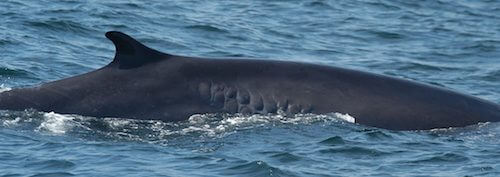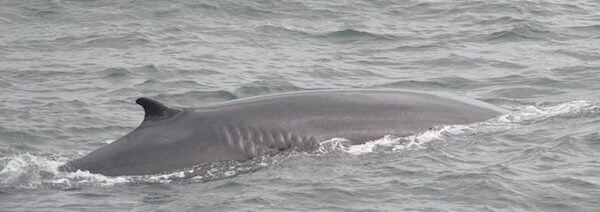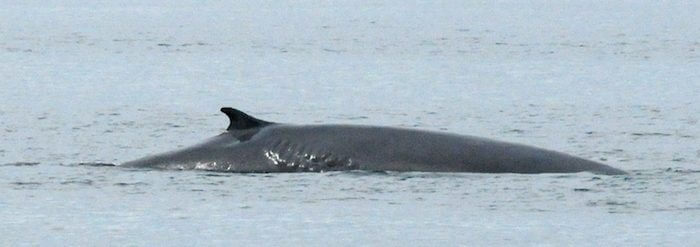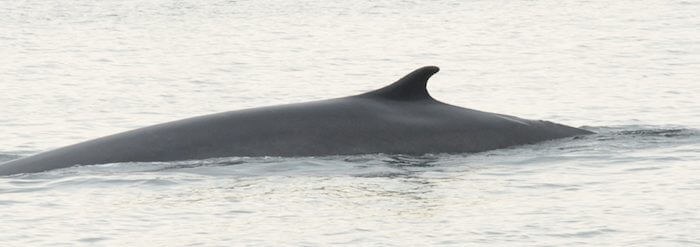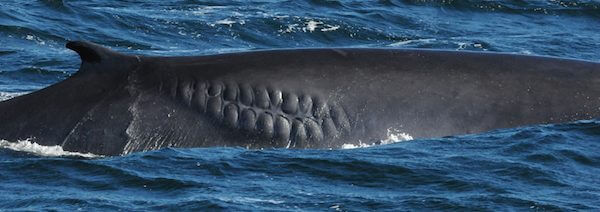Zipper
Fin Whale

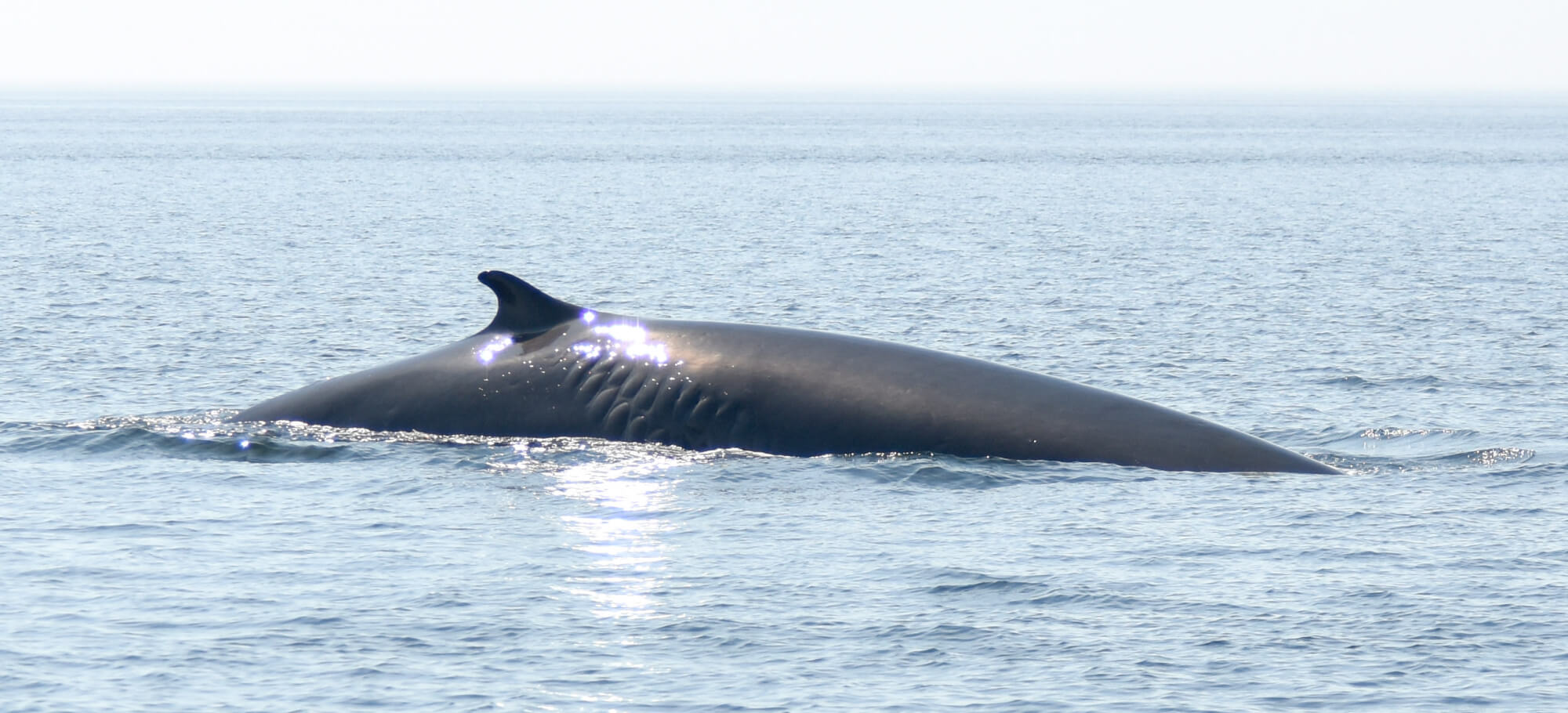
-
ID number
Bp097
-
Sex
Female
-
Year of birth
Unknown
-
Known Since
1994
Distinctive traits
One needs only to look at her right side to understand how this fin whale got her name. Zipper bears an enormous zipper-shaped scar, the result of a collision with the propeller of a ship. This fin whale also has a very pronounced scar on each side of her peduncle. On the other hand, her dorsal fin has no notches and her chevron shows little contrast.
Life history
Observers recall their first encounter with Zipper in 1994, when she was covered with fresh wounds and still ragged-looking skin. This type of injury is characteristic of a collision with a boat propeller.
Zipper survived her lacerations and continues to visit the Estuary. Her large scar reminds us that collisions between boats and marine mammals can be fatal. The vigilance of commercial and recreational boat operators, as well as compliance with the regulations of the Saguenay-St. Lawrence Marine Park (speed limits and minimum observation distances) make it possible to mitigate this risk, which becomes more acute in foggy weather or in heavily visited feeding areas.
Prior to 1994, Zipper was likely a seasonal resident of the Estuary; however, since she did not have any distinctive traits at the time, she had yet to be identified.
Zipper is just as well known in the Gulf as she is in the Estuary, which she visits regularly. She has been photographed 15 times since 1994, including GREMM’s first snapshot of her in 2007. Zipper has also been seen with two calves.
Observations history in the Estuary
Years in which the animal was not observed Years in which the animal was observed
Latest news from the publications Portrait de baleines
As you may have guessed, it is because of her zipper-shaped scar that Zipper is most recognizable. This female fin whale was identified for the first time in the estuary in 1994. Her right flank then bore a fresh and deep wound. There is no doubt that a collision with a boat caused it: an entanglement would have left marks around its mouth or its peduncle, and the regularity of the lacerations is typical of a propeller. Because adult fin whales have no known predators, human activities are their greatest threat.
Zipper’s wound is now well healed. Although they remain wet at all times, cetacean wounds heal as quickly as those of land animals, but differently. Rather than a scab, injured whales first develop a thin layer of epidermal (skin) cells that protects the tissue while it heals. Over the years, researchers have been able to observe the evolution of his scar. Given the frequency with which Zipper visits the estuary, it is possible that this whale was a regular visitor to the area prior to 1994, but that the lack of distinctive features made it difficult to recognize.
For a third time, Zipper is documented with a whale calf at her side. The difference in size is striking! At birth, the calf measures between 6 and 6.5 meters and weighs about 1800 kg (4000 lb). The mother is between 18.5 and 20 m (60 and 66 ft) long. Zipper must have given birth during the winter and weaning should be over soon, since nursing lasts about 6 to 7 months. At the end of this period, her calf will be 11 to 12 meters long, which is almost double its size at birth!
Zipper is a fin whale easily recognizable by her obvious, zipper-like scar on her right side. Her peduncle also bears clearly visible markings on either side. Her dorsal fin has two small notches and her chevron shows little contrast. In 1994, the year of her first photo-identification, this fin whale arrived in the Estuary covered with fresh wounds and ragged skin. A collision with a boat left her in this state.
A biopsy taken in 1999 helped confirm her sex: Zipper is a female. In fact, she has since had two calves (2001 and 2007). Although she was first identified in 1994, her previous visits may have gone unnoticed because of the absence of any conspicuous traits. Zipper is also well known in the Gulf of St. Lawrence, where she has been photographed numerous times since 1994.
The scars and markings of individuals visiting the Estuary evolve over time. The broad, deep scar on Zipper’s right flank has changed since her accident. The skin of cetaceans is smooth, taught and hairless, and is in contact with a marine environment where the water is salty and sometimes very cold. Despite this, it seems that scarring and healing times of cetacean wounds are comparable to those of land mammals. The process is very effective, however. Dolphin studies in both temperate and cold waters have observed the formation of a protective buffer made of degenerative cells that, when in contact with salt water, protect the wound, allowing for easier healing of the underlying tissues and closing of the wound. Unlike land mammals, there is no formation of a sort of crust or scab.
In cetaceans, salt water seems to play a role in the scarring process. Injuries inflicted by sharks or other individuals of the same species form scars that disappear after 7 to 8 months. Broader, deeper scars create deformations and pigmentation changes that seem to be permanent. A study on scarring in pilot whales has demonstrated that in less than a year, wounds caused by biopsies are closed and the healing process is complete.
One look is all it takes to identify her: his zipper-like scars on his right flank, as well as those on her stalk, are still impressive to see. Observers remember well their first encounter with Zipper in 1994 with her fresh wounds still raw and her skin in tatters. This type of injury is characteristic of a collision with a boat propeller.
This female fin whale is known in the Estuary as well as in the Gulf. She regularly visits the estuary and has been photographed there eleven times since 1994, during the months of June, July, August and even November depending on the year.
This summer, Zipper was photographed for the first time by the GREMM team on July 27. This is the first time she has spent such a long time in the estuary. At the beginning of July, she had been observed by the MICS team in the Anticosti Island sector, off Port-Menier.
Atlantic fin whales feed on capelin and krill, frequent deep waters and can live up to 100 years. In early winter, they make short migrations south, but the precise areas where they mate and calve are not well known. This second largest marine mammal (after the blue whale) tends to be solitary, but groups of up to ten individuals can form several times a day and are thought to be associated with hunting strategies.

